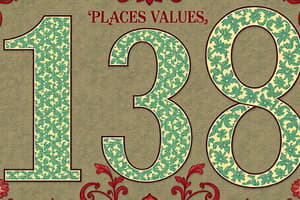Podcast
Questions and Answers
What is the purpose of grouping digits into three-digit blocks when reading large numbers?
What is the purpose of grouping digits into three-digit blocks when reading large numbers?
- To express the number in fractional notation
- To make the number easier to pronounce and understand (correct)
- To expand the number by multiplying each digit with its place value
- To represent the number in scientific notation
In the number 2,345, what do the first two groups of zeros represent?
In the number 2,345, what do the first two groups of zeros represent?
- The hundreds and thousands place
- The ones and tens place in the thousands place (correct)
- The hundreds and thousands place in the ten thousands place
- The ones and tens place in the hundreds place
Which number notation is used to express very small or very large numbers without dealing with many zeros?
Which number notation is used to express very small or very large numbers without dealing with many zeros?
- Decimal notation
- Exponential notation
- Fractional notation
- Scientific notation (correct)
What is the value of the digit 3 in the number 2,345?
What is the value of the digit 3 in the number 2,345?
How can the number 2,345 be expanded?
How can the number 2,345 be expanded?
In the number 648, what is the value of the hundreds digit?
In the number 648, what is the value of the hundreds digit?
What does the units digit represent in the number 512?
What does the units digit represent in the number 512?
If 82 is written as 820, which place value principle is being applied?
If 82 is written as 820, which place value principle is being applied?
What is the tens digit in the number 749?
What is the tens digit in the number 749?
When reading large numbers, why is understanding place value important?
When reading large numbers, why is understanding place value important?
Flashcards are hidden until you start studying
Study Notes
Reading numbers is a fundamental skill necessary for various aspects of life, such as academic performance, job requirements, and daily living activities. This skill involves understanding the concept of place value, which refers to the position of each digit within a number and its corresponding value. In this article, we will explore how to read large numbers, identify digit values, expand numbers using place value, and understand different number notations.
Place Value
The value of a digit depends on its position within a number. For instance, the digit 5 in the number 85 has a value of 50 because it is in the tens place. Similarly, the digit 9 in the number 190 has a value of 900 since it resides in the hundreds place. Understanding place value helps us to correctly interpret numbers and perform arithmetic operations.
Units Digit
The rightmost digit in any whole number represents the units digit. For example, in the number 237, the units digit is 7.
Tens Digit
The next digit from the right represents the tens digit. In the number 237, the tens digit is 3.
Hundreds Digit
Moving further left from the tens digit, we find the hundreds digit. So, in the number 237, the hundreds digit is 2.
Thousands Digit
Finally, the leftmost digit represents the thousands digit. In the number 237, the thousands digit is also 2.
Reading Large Numbers
When dealing with large numbers, it's essential to know how to read them aloud clearly. One method to do so is by grouping digits into three-digit blocks and saying each block separately, followed by their respective place names. This method makes it easier to pronounce and understand larger numbers.
For example, when reading the number 2,345, you would say "two thousand, three hundred forty-five." Here, the first two groups of zeros represent ones and tens in thousands place, while the third zero acts as a placeholder between hundreds and thousands places.
Number Notation
There are several ways to represent numbers, including decimal, fractional, scientific notation, and exponential notation. Let's examine some examples:
Decimal Notation
Decimal notation uses decimals to express fractions up to one whole unit. For example, 0.50 is equal to 1/2.
Fractional Notation
In fractional notation, a fraction consists of a numerator (top number) over a denominator (bottom number), representing a portion of a single unit. For example, 1/2 can be expressed as half of a unit.
Scientific Notation
Scientific notation allows scientists to work with very small or very large numbers without having to deal with many zeros. It involves expressing numbers between 1 and 10 in the format of power of ten times a number between 0 and 1. For example, the number 2,000 can be expressed in scientific notation as 2 x 10^3.
Exponential Notation
Similar to scientific notation, exponential notation represents large numbers using powers of ten. However, unlike scientific notation, exponential notation uses 'e' instead of 10. The base 'e' is approximately equal to 2.71828 and has many useful properties that make it particularly valuable for mathematical purposes.
Expanding Numbers
Expanding numbers involves multiplying each digit by its respective place value. To do this, simply multiply the digit by 1, 10, or 100 depending on its position. In the case of negative numbers, follow the rules for negative multiplication.
Here's an example using the number 2,345:
2 x 1,000 + 3 x 100 + 4 x 10 + 5 x 1 = 2,345.
By applying these principles, you can read and understand numbers more effectively, making complex calculations easier and more efficient.
Studying That Suits You
Use AI to generate personalized quizzes and flashcards to suit your learning preferences.




